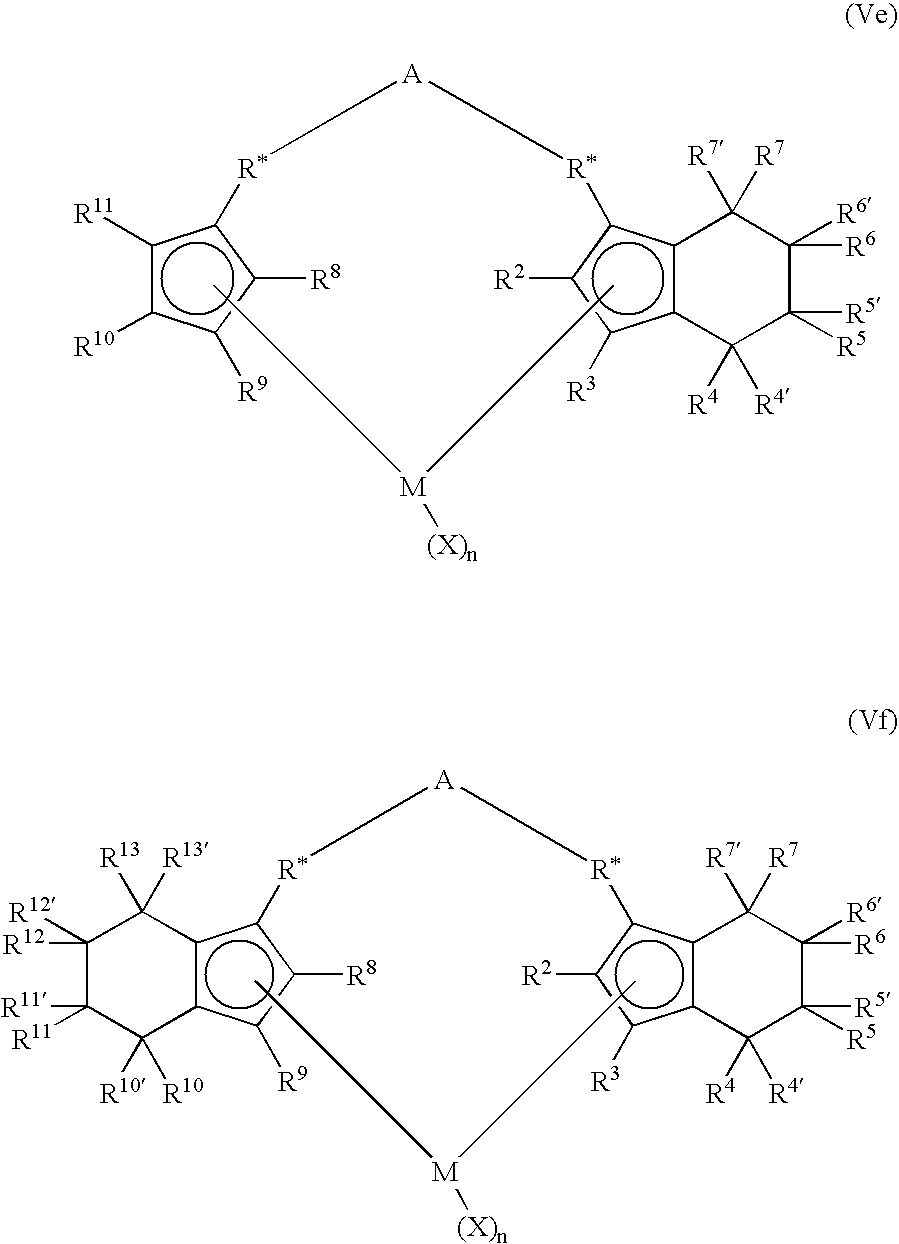Bimetallic catalyst, method of polymerization and bimodal polyolefins therefrom
a bimetallic catalyst and polymerization technology, applied in the field of bimetallic catalysts, can solve the problems of wasting a great deal of effort in discovering the improvement of such processes
- Summary
- Abstract
- Description
- Claims
- Application Information
AI Technical Summary
Benefits of technology
Problems solved by technology
Method used
Image
Examples
example 1
[0258]This example describes the preparation of various supported Ziegler-Natta catalysts that were modified; then activated with TMA; and then used in separate polymerization reactions, to produce unimodal polyethylene. The productivities of the modified Ziegler-Natta catalysts (Catalysts B and C) were substantially higher than the productivities of the unmodified Ziegler-Natta catalysts (Catalyst A).
[0259]The TMA activator was trimethylaluminum in heptane, and the ethylaluminum sesquichloride (EASC) was in toluene; both were supplied by Aldrich Chemical Company, Inc. The diethylaluminum chloride (DEAC) was in heptane, and the diethylaluminum ethoxide (DEAl-E) was in hexane; both were supplied by Akzo Nobel Polymer Chemicals LLC. Kaydol, a white mineral oil, was purchased from Witco Corporation, and was purified by first degassing with nitrogen for 1 hour, followed by heating at 80° C. under vacuum for 10 hours.
[0260]Catalyst A samples (Samples 1–6) represent unmodified Ziegler-Nat...
example 2
[0267]This example demonstrates how catalyst productivity can be affected by contacting an non-activated unmodified Ziegler-Natta catalyst simultaneously with a modifier and activator, rather than first modifying the catalyst followed by activating it. In this example, an aliquot of a Kaydol oil and non-activated Type A Catalyst (0.0191 grams) slurry was formed. This catalyst slurry was formed using the procedure described above in Example 1. The catalyst slurry was introduced to a 50 ml stainless steel bomb containing 50 ml of hexane. Anhydrous conditions were maintained.
[0268]The slurry reactor was a 1-liter, stainless steel autoclave equipped with a mechanical agitator. Before polymerization, the reactor was dried by heating at 96° C. under a stream of dry nitrogen for 40 minutes. After cooling the reactor to 50° C., hexane (500 ml) was added to the reactor, followed by 1.0 ml of TMA activator (2.0 moles) in heptane and 0.025 ml of DEAC modifier (0.04 mmoles) and also 1-hexene (4...
example 3
[0271]This example describes the preparation of two different bimetallic catalysts, reflected in Table 4, which were then used in separate polymerization reactions to produce bimodal polyethylene, the results of which are shown in Table 5.
[0272]As reflected in Table 4, a “Catalyst D” (Sample 16) was prepared as follows. DEAC (0.1 ml or 0.16 mmol) was added to a slurry of non-activated Catalyst A (0.265 g) in 13.8 grams of Kaydol oil. The resulting mixture was stirred at room temperature for 2 hours. To that slurry was added metallocene, specifically bis(n-butylcyclopentadienyl)zirconium dichloride ((BuCp)2ZrCl2), supplied by Boulder Scientific Company (0.011 g, 0.0272 mmol), along with an activator, i.e., MAO (0.85 ml, 2.64 mmol), and Kaydol (7.2 g). The combined slurry, containing the activated bimetallic catalyst was then mixed and stirred for 2 hours at room temperature, resulting in “Catalyst D.”
[0273]Also reflected in Table 4 is Catalyst E (Sample 17), which was prepared as fol...
PUM
| Property | Measurement | Unit |
|---|---|---|
| molar ratio | aaaaa | aaaaa |
| Polydispersity | aaaaa | aaaaa |
| density | aaaaa | aaaaa |
Abstract
Description
Claims
Application Information
 Login to View More
Login to View More - R&D
- Intellectual Property
- Life Sciences
- Materials
- Tech Scout
- Unparalleled Data Quality
- Higher Quality Content
- 60% Fewer Hallucinations
Browse by: Latest US Patents, China's latest patents, Technical Efficacy Thesaurus, Application Domain, Technology Topic, Popular Technical Reports.
© 2025 PatSnap. All rights reserved.Legal|Privacy policy|Modern Slavery Act Transparency Statement|Sitemap|About US| Contact US: help@patsnap.com


